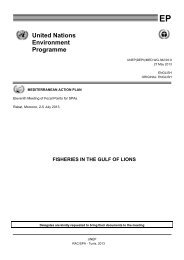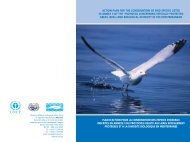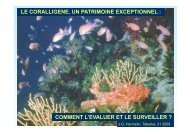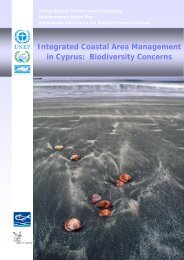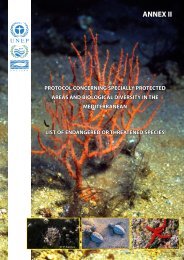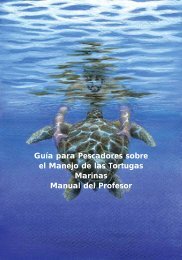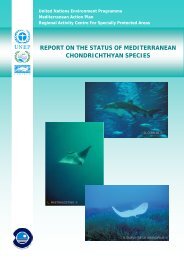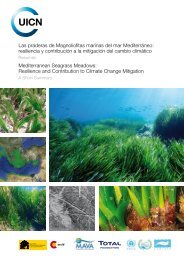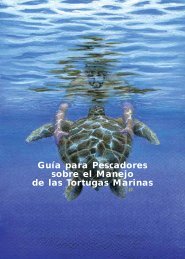Proceedings of the Second Mediterranean Symposium on Marine
Proceedings of the Second Mediterranean Symposium on Marine
Proceedings of the Second Mediterranean Symposium on Marine
Create successful ePaper yourself
Turn your PDF publications into a flip-book with our unique Google optimized e-Paper software.
CONTRIBUTION TO THE KNOWLEDGE OF THE BENTHIC MARINE<br />
MACROALGAE FROM MANI REGION (MESSINIAKOS GULF, GREECE)<br />
Anastasia TSIRIKA, Dimitris PATOUCHEAS & Sawas HARITONIDIS<br />
Aristotle University <str<strong>on</strong>g>of</str<strong>on</strong>g> Thessal<strong>on</strong>iki, Department <str<strong>on</strong>g>of</str<strong>on</strong>g> Biology, Institute <str<strong>on</strong>g>of</str<strong>on</strong>g> Botany, GR- 541 24, Thessal<strong>on</strong>iki, GREECE<br />
ABSTRACT<br />
Limited informati<strong>on</strong> is available <strong>on</strong> <str<strong>on</strong>g>the</str<strong>on</strong>g> benthic marine flora <str<strong>on</strong>g>of</str<strong>on</strong>g> Pelop<strong>on</strong>nese and no data<br />
are provided for <str<strong>on</strong>g>the</str<strong>on</strong>g> Southwestern part <str<strong>on</strong>g>of</str<strong>on</strong>g> Mani regi<strong>on</strong> (Messiniakos Gulf). The current<br />
study, including certain biotopes <str<strong>on</strong>g>of</str<strong>on</strong>g> <str<strong>on</strong>g>the</str<strong>on</strong>g> Mani regi<strong>on</strong> (Hotassia, Oitilo and Aeropolis), aims<br />
at a broader c<strong>on</strong>tributi<strong>on</strong> to <str<strong>on</strong>g>the</str<strong>on</strong>g> survey <str<strong>on</strong>g>of</str<strong>on</strong>g> <str<strong>on</strong>g>the</str<strong>on</strong>g> Greek marine flora. All sample collecti<strong>on</strong>s<br />
were accomplished with SCUBA-diving during <str<strong>on</strong>g>the</str<strong>on</strong>g> spring and autumn <str<strong>on</strong>g>of</str<strong>on</strong>g> 2002 and 2003.<br />
The studied sites are characterized by <str<strong>on</strong>g>the</str<strong>on</strong>g> intense presence <str<strong>on</strong>g>of</str<strong>on</strong>g> hard substrate from 0m<br />
down to 50m depth, with <str<strong>on</strong>g>the</str<strong>on</strong>g> excepti<strong>on</strong> <str<strong>on</strong>g>of</str<strong>on</strong>g> few sandy coasts. Samples were collected<br />
from 0-2m and 35-40m depth. In total, <str<strong>on</strong>g>the</str<strong>on</strong>g> samples c<strong>on</strong>tained 147 taxa. From <str<strong>on</strong>g>the</str<strong>on</strong>g><br />
identified species, <str<strong>on</strong>g>the</str<strong>on</strong>g> red algae dominate qualitatively with 99 representatives, whereas<br />
<str<strong>on</strong>g>the</str<strong>on</strong>g> phaeophyceae and green algae participate with 28 and 20 representatives,<br />
respectively. The Cystoseira spp. communities c<strong>on</strong>stitute a source <str<strong>on</strong>g>of</str<strong>on</strong>g> floristic richness <strong>on</strong><br />
hard substrate, form a productive belt that plays an important ecological role and shape<br />
most <str<strong>on</strong>g>of</str<strong>on</strong>g> <str<strong>on</strong>g>the</str<strong>on</strong>g> rocky underwater landscape in <str<strong>on</strong>g>the</str<strong>on</strong>g> <str<strong>on</strong>g>Mediterranean</str<strong>on</strong>g> Sea. C<strong>on</strong>cerning <str<strong>on</strong>g>the</str<strong>on</strong>g> depth<br />
<str<strong>on</strong>g>of</str<strong>on</strong>g> 0-2m, significant was <str<strong>on</strong>g>the</str<strong>on</strong>g> presence <str<strong>on</strong>g>of</str<strong>on</strong>g> <str<strong>on</strong>g>the</str<strong>on</strong>g> photophilus associati<strong>on</strong> <str<strong>on</strong>g>of</str<strong>on</strong>g> Cystoseira<br />
amentacea and <str<strong>on</strong>g>the</str<strong>on</strong>g> photophilus associati<strong>on</strong> <str<strong>on</strong>g>of</str<strong>on</strong>g> Cystoseira compressa accompanied by<br />
Cystoseira barbatula and Ch<strong>on</strong>drophycus papillosus. Moreover, at <str<strong>on</strong>g>the</str<strong>on</strong>g> lower midlittoral<br />
and upper sublittoral z<strong>on</strong>e <str<strong>on</strong>g>the</str<strong>on</strong>g> red alga Tenarea tortuosa covered extended areas. At <str<strong>on</strong>g>the</str<strong>on</strong>g><br />
depth <str<strong>on</strong>g>of</str<strong>on</strong>g> 35-40m <str<strong>on</strong>g>the</str<strong>on</strong>g> associati<strong>on</strong> <str<strong>on</strong>g>of</str<strong>on</strong>g> Cystoseira spinosa and <str<strong>on</strong>g>the</str<strong>on</strong>g> associati<strong>on</strong> <str<strong>on</strong>g>of</str<strong>on</strong>g> Cystoseira<br />
foeniculacea f. schiffneri were recorded. At that depth very important was <str<strong>on</strong>g>the</str<strong>on</strong>g> presence<br />
<str<strong>on</strong>g>of</str<strong>on</strong>g> <str<strong>on</strong>g>the</str<strong>on</strong>g> brown alga Sargassum acinarium accompanied by dense populati<strong>on</strong>s <str<strong>on</strong>g>of</str<strong>on</strong>g> <str<strong>on</strong>g>the</str<strong>on</strong>g><br />
epiphytic and epilithic Callithamni<strong>on</strong> granulatum. All over <str<strong>on</strong>g>the</str<strong>on</strong>g> substrate at 35-40m depth<br />
dense turfs <str<strong>on</strong>g>of</str<strong>on</strong>g> <str<strong>on</strong>g>the</str<strong>on</strong>g> filamentous red macroalga Womersleyella setacea occurred. This<br />
species, described originally from <str<strong>on</strong>g>the</str<strong>on</strong>g> Hawaiian Islands and later reported from o<str<strong>on</strong>g>the</str<strong>on</strong>g>r<br />
tropical localities, has recently become widespread in <str<strong>on</strong>g>the</str<strong>on</strong>g> <str<strong>on</strong>g>Mediterranean</str<strong>on</strong>g> Sea. In Greece,<br />
it has been observed at North and South Aegean Sea. No sporangia or sexual<br />
reproductive structures were observed at <str<strong>on</strong>g>the</str<strong>on</strong>g> specimens <str<strong>on</strong>g>of</str<strong>on</strong>g> <str<strong>on</strong>g>the</str<strong>on</strong>g> studied site. Ano<str<strong>on</strong>g>the</str<strong>on</strong>g>r pantropical<br />
to temperate-warm water species that is currently experiencing a dramatic and<br />
c<strong>on</strong>tinuous spread throughout most <str<strong>on</strong>g>of</str<strong>on</strong>g> <str<strong>on</strong>g>the</str<strong>on</strong>g> <str<strong>on</strong>g>Mediterranean</str<strong>on</strong>g> Sea was recorded at <str<strong>on</strong>g>the</str<strong>on</strong>g><br />
studied sites. The green alga Caulerpa racemosa occurred at 0-2m, as well as at 35-40m<br />
depth, expanding <strong>on</strong> rocky substrate, benthic fauna, encrusting algae as Corallinaceae<br />
and Peyss<strong>on</strong>nelia spp., turf species and erect algae. The species expansi<strong>on</strong> was much<br />
more significant at deep water than at shallow water biocommunities. Specimens <str<strong>on</strong>g>of</str<strong>on</strong>g><br />
Caulerpa racemosa from Mani regi<strong>on</strong> possessed uncrowded radial to distichous<br />
branchlets and <str<strong>on</strong>g>the</str<strong>on</strong>g> branchlets shape was clavate with rounded apex. The morphology <str<strong>on</strong>g>of</str<strong>on</strong>g><br />
<str<strong>on</strong>g>the</str<strong>on</strong>g> specimens indicates that <str<strong>on</strong>g>the</str<strong>on</strong>g>y bel<strong>on</strong>g to <str<strong>on</strong>g>the</str<strong>on</strong>g> invasive variety Caulerpa racemosa var.<br />
occidentalis. The species Laurencia ch<strong>on</strong>drioides and Osmundea pelagosae are<br />
recorded for <str<strong>on</strong>g>the</str<strong>on</strong>g> first time at <str<strong>on</strong>g>the</str<strong>on</strong>g> Greek coasts in <str<strong>on</strong>g>the</str<strong>on</strong>g> present study. Both species were<br />
found to grow as epiphytes at <str<strong>on</strong>g>the</str<strong>on</strong>g> depth <str<strong>on</strong>g>of</str<strong>on</strong>g> 35-40m.<br />
ACTES DU DEUXIEME SYMPOSIUM MEDITERRANEEN SUR LA VEGETATION MARINE (ATHENES, 12-13 DECEMBRE 2003)<br />
245




